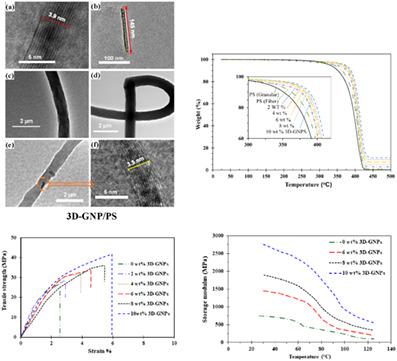当前位置:
X-MOL 学术
›
Polym. Compos.
›
论文详情
Our official English website, www.x-mol.net, welcomes your
feedback! (Note: you will need to create a separate account there.)
Morphological, mechanical, and thermal characterization of electrospun three‐dimensional graphite nanoplatelets/polystyrene ultra‐fine fibril composite fabrics
Polymer Composites ( IF 4.8 ) Pub Date : 2021-01-13 , DOI: 10.1002/pc.25916 A. S. Fayed 1 , K. A. Abu‐Hasel 2 , Sameh M. Mahdy 3 , Ashraf A. Ali 2, 3
Polymer Composites ( IF 4.8 ) Pub Date : 2021-01-13 , DOI: 10.1002/pc.25916 A. S. Fayed 1 , K. A. Abu‐Hasel 2 , Sameh M. Mahdy 3 , Ashraf A. Ali 2, 3
Affiliation

|
Ultra‐fine fibril composites were produced by electrospinning of a polymer solution containing polystyrene (PS)/dimethylformamide (DMF) with different concentrations of three‐dimensional graphite nanoplatelets (3D‐GNPs). Berry's number of PS/DMF polymer solution was extensively studied to produce minimum electrospun PS fiber diameters. Three‐dimensional GNPs of different weight percentages were dispersed in the optimized PS/DMF to produce ultrafine fibril composite fabric. The electrospun average diameters decreased from 1.5 μm for PS fibers to 890 nm for 3D‐GNPs/PS fibril composites, respectively, at 12 and 9.8 Berry's number. High‐resolution transmission electron microscopy samples' micrographs confirm a homogenous dispersion and alignment of 3D‐GNPs in PS fibril composites. Thermal and mechanical characteristics of fabrics were determined using thermogravimetric analysis, thermomechanical Analysis, and dynamic mechanical analysis (DMA). It was found that there was an increase in percentage elongation, tensile strength, thermal stability, and glass‐transition temperature for 3D‐GNPs PS fibril composite fabrics compared to PS fabrics. Diminishing the value of loss tangent, measured by DMA, was used as an approach to predict the maximum amount of 3D‐GNPs weight percent dispersion in electrospun PS/dimethylformamide solution. One of the most important potential applications of the electrospun 3D‐GNPs/PS fibril composite fabrics is in the interiors of vehicles and aerospace industries as it characterizes by its good thermal and mechanical properties as well as its low density.
中文翻译:

电纺三维石墨纳米片/聚苯乙烯超细原纤维复合织物的形貌,力学和热学性质
超细原纤维复合材料是通过将含有聚苯乙烯(PS)/二甲基甲酰胺(DMF)和不同浓度的三维石墨纳米片(3D-GNPs)的聚合物溶液静电纺丝制成的。对Berry的PS / DMF聚合物溶液的数量进行了广泛的研究,以产生最小的电纺PS纤维直径。将不同重量百分比的三维GNP分散在优化的PS / DMF中,以生产超细原纤维复合织物。3D-GNPs / PS原纤维复合材料的静电纺丝平均直径分别从1.5微米(PS纤维)降低到890纳米,分别为12和9.8贝里数。高分辨率透射电子显微镜样品的显微照片证实了PS原纤维复合材料中3D-GNP的均匀分散和排列。使用热重分析,热力学分析和动态力学分析(DMA)确定织物的热和机械特性。研究发现,与PS织物相比,3D-GNPs PS原纤维复合织物的伸长率,拉伸强度,热稳定性和玻璃化转变温度都有所提高。减少通过DMA测得的损耗角正切值,可以用作预测电纺丝PS /二甲基甲酰胺溶液中3D-GNPs重量百分比分散最大量的方法。电纺3D-GNPs / PS原纤维复合面料最重要的潜在应用之一是在汽车和航空航天工业的内部,因为它具有良好的热和机械性能以及低密度。热力学分析和动态力学分析(DMA)。研究发现,与PS织物相比,3D-GNPs PS原纤维复合织物的伸长率,拉伸强度,热稳定性和玻璃化转变温度都有所提高。减少通过DMA测得的损耗角正切值,可以用作预测电纺丝PS /二甲基甲酰胺溶液中3D-GNPs重量百分比分散最大量的方法。电纺3D-GNPs / PS原纤维复合面料最重要的潜在应用之一是在汽车和航空航天工业的内部,因为它具有良好的热和机械性能以及低密度。热力学分析和动态力学分析(DMA)。研究发现,与PS织物相比,3D-GNPs PS原纤维复合织物的伸长率,拉伸强度,热稳定性和玻璃化转变温度都有所提高。减少通过DMA测得的损耗角正切值,可以用作预测电纺丝PS /二甲基甲酰胺溶液中3D-GNPs重量百分比分散最大量的方法。电纺3D-GNPs / PS原纤维复合面料最重要的潜在应用之一是在汽车和航空航天工业的内部,因为它具有良好的热和机械性能以及低密度。3D-GNPs PS原纤维复合织物的热稳定性和玻璃化转变温度与PS织物相比。减少通过DMA测得的损耗角正切值,可以用作预测电纺丝PS /二甲基甲酰胺溶液中3D-GNPs重量百分比分散最大量的方法。电纺3D-GNPs / PS原纤维复合面料最重要的潜在应用之一是在汽车和航空航天工业的内部,因为它具有良好的热和机械性能以及低密度。与PS织物相比,3D-GNPs PS原纤维复合织物的热稳定性和玻璃化转变温度。减少通过DMA测得的损耗角正切值,可以用作预测电纺丝PS /二甲基甲酰胺溶液中3D-GNPs重量百分比分散最大量的方法。电纺3D-GNPs / PS原纤维复合面料最重要的潜在应用之一是在汽车和航空航天工业的内部,因为它具有良好的热和机械性能以及低密度。用作预测3D-GNPs在静电纺丝PS /二甲基甲酰胺溶液中最大分散百分数的方法。电纺3D-GNPs / PS原纤维复合面料最重要的潜在应用之一是在汽车和航空航天工业的内部,因为它具有良好的热和机械性能以及低密度。用作预测3D-GNPs在静电纺丝PS /二甲基甲酰胺溶液中最大分散百分数的方法。电纺3D-GNPs / PS原纤维复合面料最重要的潜在应用之一是在汽车和航空航天工业的内部,因为它具有良好的热和机械性能以及低密度。
更新日期:2021-03-08
中文翻译:

电纺三维石墨纳米片/聚苯乙烯超细原纤维复合织物的形貌,力学和热学性质
超细原纤维复合材料是通过将含有聚苯乙烯(PS)/二甲基甲酰胺(DMF)和不同浓度的三维石墨纳米片(3D-GNPs)的聚合物溶液静电纺丝制成的。对Berry的PS / DMF聚合物溶液的数量进行了广泛的研究,以产生最小的电纺PS纤维直径。将不同重量百分比的三维GNP分散在优化的PS / DMF中,以生产超细原纤维复合织物。3D-GNPs / PS原纤维复合材料的静电纺丝平均直径分别从1.5微米(PS纤维)降低到890纳米,分别为12和9.8贝里数。高分辨率透射电子显微镜样品的显微照片证实了PS原纤维复合材料中3D-GNP的均匀分散和排列。使用热重分析,热力学分析和动态力学分析(DMA)确定织物的热和机械特性。研究发现,与PS织物相比,3D-GNPs PS原纤维复合织物的伸长率,拉伸强度,热稳定性和玻璃化转变温度都有所提高。减少通过DMA测得的损耗角正切值,可以用作预测电纺丝PS /二甲基甲酰胺溶液中3D-GNPs重量百分比分散最大量的方法。电纺3D-GNPs / PS原纤维复合面料最重要的潜在应用之一是在汽车和航空航天工业的内部,因为它具有良好的热和机械性能以及低密度。热力学分析和动态力学分析(DMA)。研究发现,与PS织物相比,3D-GNPs PS原纤维复合织物的伸长率,拉伸强度,热稳定性和玻璃化转变温度都有所提高。减少通过DMA测得的损耗角正切值,可以用作预测电纺丝PS /二甲基甲酰胺溶液中3D-GNPs重量百分比分散最大量的方法。电纺3D-GNPs / PS原纤维复合面料最重要的潜在应用之一是在汽车和航空航天工业的内部,因为它具有良好的热和机械性能以及低密度。热力学分析和动态力学分析(DMA)。研究发现,与PS织物相比,3D-GNPs PS原纤维复合织物的伸长率,拉伸强度,热稳定性和玻璃化转变温度都有所提高。减少通过DMA测得的损耗角正切值,可以用作预测电纺丝PS /二甲基甲酰胺溶液中3D-GNPs重量百分比分散最大量的方法。电纺3D-GNPs / PS原纤维复合面料最重要的潜在应用之一是在汽车和航空航天工业的内部,因为它具有良好的热和机械性能以及低密度。3D-GNPs PS原纤维复合织物的热稳定性和玻璃化转变温度与PS织物相比。减少通过DMA测得的损耗角正切值,可以用作预测电纺丝PS /二甲基甲酰胺溶液中3D-GNPs重量百分比分散最大量的方法。电纺3D-GNPs / PS原纤维复合面料最重要的潜在应用之一是在汽车和航空航天工业的内部,因为它具有良好的热和机械性能以及低密度。与PS织物相比,3D-GNPs PS原纤维复合织物的热稳定性和玻璃化转变温度。减少通过DMA测得的损耗角正切值,可以用作预测电纺丝PS /二甲基甲酰胺溶液中3D-GNPs重量百分比分散最大量的方法。电纺3D-GNPs / PS原纤维复合面料最重要的潜在应用之一是在汽车和航空航天工业的内部,因为它具有良好的热和机械性能以及低密度。用作预测3D-GNPs在静电纺丝PS /二甲基甲酰胺溶液中最大分散百分数的方法。电纺3D-GNPs / PS原纤维复合面料最重要的潜在应用之一是在汽车和航空航天工业的内部,因为它具有良好的热和机械性能以及低密度。用作预测3D-GNPs在静电纺丝PS /二甲基甲酰胺溶液中最大分散百分数的方法。电纺3D-GNPs / PS原纤维复合面料最重要的潜在应用之一是在汽车和航空航天工业的内部,因为它具有良好的热和机械性能以及低密度。











































 京公网安备 11010802027423号
京公网安备 11010802027423号